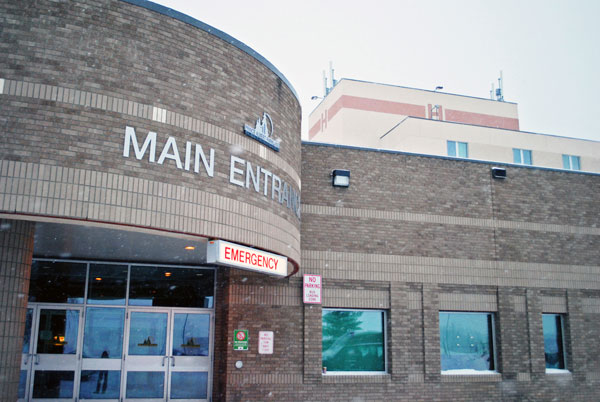Hospitals in North Battleford and Prince Albert have had to severely limit elective surgeries while north region and Saskatoon area ICUS are running below targeted ICU capacity due to challenges caused by COVID-19 case counts, the province revealed Thursday.
Saskatchewan’s Chief Medical Health Officer Dr. Saqib Shahab and Saskatchewan Health Authority (SHA) executive director Scott Livingstone updated reporters and the public on the current status of case counts and the situation within the health care system.
There is some cause for optimism — Saskatchewan’s daily new case count has reduced slightly and its pandemic curve is beginning to flatten out as the effects of recent public health measures begin to be visible.
The province, though, is still far above where it needs to be to effectively manage COVID-19 case counts and protect the health care system.
“We’re not out of the woods yet, but things are looking positive,” Shahab said.
“It’s’ going to be so important to keep doing what we’re doing so we can see low cases throughout the holiday season and look forward to January.”
Saskatchewan reported seven new COVID-19 deaths Thursday, including a resident from the North Central Zone in their 60s. Five of the deaths were of residents in the 80-plus age group. The South East Zone reported a death of someone in their 40s.
Along with the deaths, Saskatchewan reported 238 new cases and 466 recoveries, bringing the active total to 2,978. The seven-day average of new daily cases is 230, or 19 per 100,000 population. The goal is to get that case average daily count to 120 or lower.
In total, 126 people are in the hospital. The North Central has 16 inpatients and five in the ICU. Saskatoon and Regina have nine and eight ICU patients respectively.
The issue, the SHA said, isn’t space. Rather, it’s staffing.
“We have beds and space and equipment, ventilators and oxygen. Actually bringing the highly-trained staff is a challenge,” said Derek Miller, who is overseeing the SHA’s COVID-19 operations centre.
“One of the ways we’re doing this is by pulling down services like surgeries, which allows us to reallocate the capacity of surgical units.”
That includes staff who can be trained to support the ICU.
Relying on surgical staff to help out in intensive care seems to be the strategy in the health authority’s integrated north zone, which includes Prince Albert. A graphic shows that it’s HR/staffing is below capacity due to high caseloads and is an area of significant concern.
In North Battleford, all elective surgeries have been cancelled for the time being. In Prince Albert, nearly all non-urgent, emergent and cancer operations have met the same fate.
Regina and Saskatoon have only seen a 35 per cent reduction in surgeries.
Of the 900 services tracked province-wide, 200 have been slowed down to free up staff to help with the pandemic response.
The ICU isn’t the only place the SHA is looking to add staff. The health authority is also in the process of creating pools of health care workers in six areas for outbreak response. They’re aiming to find 300-400. So far, they’ve identified 117.
They’ve also been attempting to bring in people through the labour market, or by activating retired or non-practicing personnel and volunteers.
The importance of this was highlighted with the Extendicare Parkside outbreak in Regina. That one outbreak has been linked to 78 positive cases among residents, 82 positive cases in staff and 20 deaths.
The SHA recently signed an agreement to take over operations for the time being at the private care home, and more than 70 staff have been sent to help. With more than 150 long-term care homes, dozens of hospitals and hundreds of private personal care homes, similar outbreaks could mean Saskatchewan would be short of thousands of staff members.
“That’s why it’s critical for us to have these service slowdowns,” Livingstone said.
“We can’t turn our services around on a dime. We can’t meet contract tracing and testing … without extraordinary efforts and we can’t deliver some of the added measures we’re working on to save lives, including point of care testing and vaccine delivery. Both of these require extra staff and will require extra resources.”
The SHA said its contact tracing teams are generally meeting target times to notify people of positive cases, but are struggling with contact notification and daily case monitoring. Some of that work requires the use of licensed health care professionals, further putting a strain on an already struggling system. Other steps, such as case investigation and finding contact names, can be done by non-medical staff.
The challenge goes beyond pure numbers. The high volume of outbreaks is leading to a high number of self-isolating staff.
“One of the biggest challenges we’re facing is the number of staff that are being taken out of service because they’re positive or have been exposed and are a close contact,” Livingstone said.
“This has been a significant impact and has contributed to the slowdown in services across the province, but also contributes to our challenge of providing support where outbreaks are occurring because of the expectation of the SHA to support staffing in other facilities we wouldn’t normally be in.”
Widespread community transmission is leading to more COVID-19 affecting health care workers and entering facilities. “It has a widespread effect,” Livingstone said.
He issued a challenge to Saskatchewan residents.
“There are many out there who are vulnerable for getting COIVD-19 and we know there are lives on the line,” he said.
‘When you think about what you have to give up this Christmas, think of it as a gift to someone who will get to experience next Christmas because you helped save their life.”


